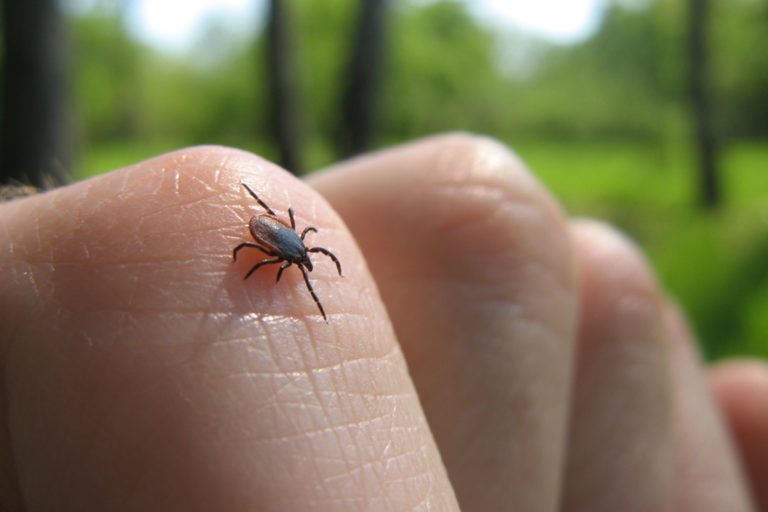
Anatomy of a Tick Bite
Ticks in the summer are as certain as heatwaves and higher A/C bills. Consider there are at least 15 tick-borne diseases, with Lyme disease the most common in the United States. The Centers for Disease Control and Prevention recommends a zero tolerance policy for allowing ticks to feed on us.
Using tick repellent isn’t all you can do to protect yourself. These smart devices ward off bugs.
The way the tick delivers its pathogens is not for the faint of heart, as described by the University of Alabama at Birmingham (UAB) in a news release about ticks and tick-borne illness. A tick uses incisor-like claws to tunnel beneath the skin, often in seconds, latching on with two legs and cutting open the skin with a mouth that resembles a reciprocating saw. After injecting its long, jagged mouth, it begins to draw blood up slowly before it reverses the flow, releasing saliva into the wound. Here’s what to do if you find a tick in your house.
What You Should Be Concerned About
There are two main concerns with a tick bite, says Pat Salber, M.D. One is an infection from the breaking of the skin itself, which allows bacteria to contaminate the open wound. The other is disease. But for a tick to actually transmit a tick-borne illness, it needs to be attached for about 24 hours, says Walter Schrading, M.D., director of the UAB’s Office of Wilderness Medicine and associate professor in UAB’s School of Medicine.
To protect yourself from ticks, Dr. Schrading recommends insect repellents containing DEET or permethrin. He also suggests wearing long pants and socks if tick habitats like woodlands and brushy areas cannot be avoided.
After spending time in such areas, you should always check for ticks. Dr. Salber explains how:
Take off all your clothes and look over every part of your body from head to toe. That means standing in front of a mirror to check your backside as well. Be sure to carefully run your fingers through your hair as well, looking in the mirror as you do. Having a partner’s eyes on you as well, can be helpful. If your dog went with you on the hike, he deserves a thorough tick check as well. Ticks come in all sizes, some can be quite small and some can be large if they have are engorged from just having finished a blood meal.
How to Remove the Tick
If you see a tick, “remain calm,” advises Jorge Parada, M.D., medical advisor for the National Pest Management Association. You’ll need to remove it immediately and completely. Dr. Parada offers the following method:
Gently pull back any hair from around the tick, exposing the skin near the tick/bite. Locate the head of the tick, grasp it as close to the skin as possible using fine-tipped tweezers and gently squeeze. Do not grab the tick’s body, as this can increase the chance of injecting the tick’s blood into the skin. Pull outward in a straight motion until the pressure pulls out the head of the tick. Do not twist or wiggle the tick, as that may tear the head off, leaving it lodged in the skin.
“If the mouth parts break off, leave them alone because your body will expel them on their own,” advises Dr. Salber. Whatever you do, he says, don’t try to dig them out because that’s a recipe for a bacterial skin infection.
Removing ticks should always be followed by hand-washing and cleansing the bite area with soap and water, rubbing alcohol or an iodine solution to avoid bacterial infection. What you should not do is try to burn the tick off your skin with a match or paint it with nail polish, because neither works, according to Jeremy Allen, M.D., a physician with American Family Care. Plus, check out these common myths about personal insect repellents.
Watch the American Academy of Dermatology’s video on exactly how to remove a tick:
Should You Save the Tick for Further Testing?
There is some disagreement among experts about saving the tick for testing for specific tick-borne illness. But it is widely accepted that it can be helpful to take photos or describe the tick. Identifying the species narrows down which illnesses you may be at risk for. For example, Lyme disease is transmitted only by deer ticks. Here’s how to avoid deer ticks.
You don’t necessarily need to see your doctor after removing a tick. But if you believe it was a deer tick and was attached to you for at least 24 hours, your doctor may be willing to prescribe a prophylactic antibiotic (200 mg of doxycycline within 72 hours after the bite). according to Joshua Zeichner, M.D., a dermatologist in New York. Even if you don’t see your doctor immediately, you should continue to monitor the bite for the expanding redness, which would suggest the characteristic rash associated with Lyme disease, says Dr. Salber.
“The salmon-colored rash expands over a few days to weeks and can get as big as eight inches in diameter,” he says. “It may eventually become clear in the center, creating what is known as a `bulls-eye’ lesion.” Nearly 80 percent of people with Lyme disease develop this rash, so if you notice it, see a doctor quickly because Lyme disease can be treated effectively when caught early. If not, Lyme disease can develop into a chronic illness. Ticks are dangerous, as are these other bugs, so it’s important to learn how to avoid them!
Article source here: Here Is How to Remove a Tick (And What Not to Do)

No comments:
Post a Comment